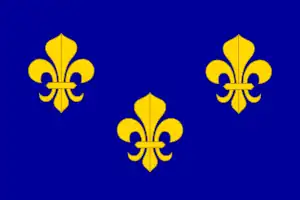| |||||
| Decades: |
| ||||
|---|---|---|---|---|---|
| See also: | Other events of 1606 History of France • Timeline • Years | ||||
Events from the year 1606 in France
Incumbents
Events
- February 12 – Maximilien de Béthune becomes 1st Duke of Sully in the Peerage of France.[2]
- February 24 – Commercial treaty between France and England signed in Paris.[3]
- March 15 – The king leaves Paris to besiege Sedan and end the revolt of the Duke of Bouillon, who submits on April 2.[4] On April 6 the king enters the town[5] and on April 28 returns to Paris.[2]
- March 22 – The assembly of the French clergy grants the king a "free gift" (dons gratuits) of 130,000 livres.[6]
- April 2 – Treaty for the protection of the Principality of Sedan.[7]
- June 3 – The Duke of Sully is named captain lieutenant in the Queen’s company.[8]
- June 9 – Accident at the Neuilly-sur-Seine ferry: the king and queen with others of the court, returning from Saint-Germain to Paris, nearly drown.[2] The king orders construction of the first, wooden, Pont de Neuilly, built between 1609 and 1611.
- December 18 – Richelieu is nominated Bishop of Luçon.[9]
- December – Edict on reform of the Catholic clergy.[5]
Births
- February 10 – Christine of France, Duchess of Savoy (d. 1663)
- February 27 – Laurent de La Hyre, Baroque painter (d. 1656)
- April 6 – Amable de Bourzeys, writer and academic (d. 1672)
- June 6 – Pierre Corneille, dramatist (d. 1684)
- July 13 – Roland Fréart de Chambray, architectural theorist (d. 1676)
- October 1 – Julian Maunoir, Jesuit priest (d. 1683)
- October 30 – Jean-Jacques Bouchard, erotic writer (d. 1641)
- November 12 – Jeanne Mance, nurse and settler in Montreal (d. 1673)
- date unknown
- Pierre du Ryer, dramatist (d. 1658)
- Charles Errard, painter, architect and engraver (d. 1689)
Deaths
- March 25 – François de Bar, French scholar (b. 1538)
- October 5 – Philippe Desportes, French poet (b. 1546)
See also
References
- ↑ "Henry IV, King of France (b. 1553, r. 1589–1610)". www.metmuseum.org. Retrieved 7 June 2022.
- 1 2 3 Rapin, Nicolas (1982). Œuvres. Vol. 1. Geneva: Librairie Droz. p. PR125. ISBN 9782600025690 – via Google Books.
- ↑ de Milititz, Alexander (1839). Manuel des consuls: Établissement des consulats à l'étranger. Vol. 2. London: A. Asher. p. 65 – via Google Books.
- ↑ de La Barre Duparcq, Édouard (1875). Henri IV et nos frontières. Librairie pour l'art militaire, les sciences et les arts. p. 18 – via Google Books.
- 1 2 Mironneau, Paul (2005). Henri IV. Éditions Jean-Paul Gisserot. p. 149. ISBN 9782877477857 – via Google Books.
- ↑ de Caulet, Jean (1752). Lettre II et III [contre les lettres ne repugnate, et autres écrits]. p. 40 – via Google Books.
- ↑ Recueil des traitez de paix, de trêve, de neutralité, de confédération, d'alliance et de commerce, faits par les rois de France. Vol. 3. Frédéric Leonard. 1693. p. 529 – via Google Books.
- ↑ Aristide, Isabelle (2014). La fortune de Sully. Institut de la gestion publique et du développement économique. p. 46. ISBN 9782821842281.
- ↑ d'Albis, Cécile (2012). Richelieu: L'essor d'un nouvel équilibre européen. Paris: Armand Colin. p. PT30. ISBN 9782200275822 – via Google Books.
This article is issued from Wikipedia. The text is licensed under Creative Commons - Attribution - Sharealike. Additional terms may apply for the media files.
